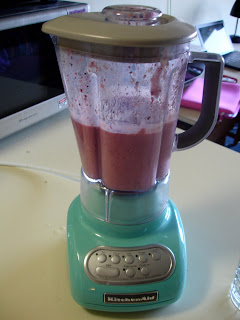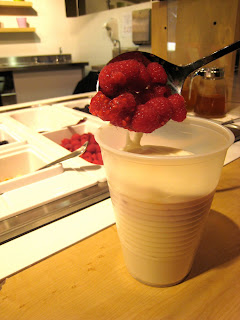
Banitsa is essentially composed of five things: phyllo (filo) dough, cheese, eggs, yogurt and sunflower oil. Sound easy? If you're 5000 miles away from home, not really. However, one of the numerous advantages of being a Penn student is the urban location, which immensely increases the chances of finding exotic foods such as phyllo. During my freshman year, I was amazed to discover packets of it in the chilled foods section at Fresh Grocer. The phyllo was Greek and thinner than the Bulgarian one, yet I made banitsa with it two or three times and it always turned out delightfully satisfying.
So how do you actually make banitsa? First, you need a cup of Bulgarian white cheese (you can find it in Fresh Grocer), broken down into small pieces. Mix it with a cup of yogurt - at Penn, I use Danone low-fat. Add two or three beaten eggs to the mixture and stir very well. Proportions can always vary according to taste - if you prefer your banitsa juicier, use more eggs and yogurt; if you like it chunkier, add more cheese (but keep in mind that Bulgarian white cheese at Fro Gro is very salty, if it's not in brine, so make sure the finished mixture is not too salty). If you decide to go the lazy amateur way and use store-bought phyllo like me, you can prepare the pastry in two ways.
1. Spread some vegetable oil on the bottom of a baking tin. Place three thin sheets of phyllo in it, spread oil on top. Repeat. Spread one third of the egg, cheese and yogurt mixture on the dough. Add six more sheets, then again filling.Repeat until you have no sheets or filling left. Ideally, those two should coincide, but if you are almost out of filling halfway through the phyllo packet, just mix in some more yogurt and cheese and go on. Finish off with phyllo, generously spread some oil on top, cut the banitsa into rectangles or triangles, depending on the shape of the baking tin, and bake at 350F(180C) for half an hour to 45 minutes, until the top and bottom are golden brown.
2. To prepare banitsa in a fancier way: instead of layering the dough and filling, take three sheets together, oil them, put filling on top and roll them up. Repeat for the rest of the packet. Next, either place the rolls next to one another in a rectangular baking tin, or roll them up as a spiral in a circular tin, starting from the center.
If you feel you have had enough practice with store-bought phyllo banitsa, you might want to go the professional/traditional way and try to prepare it with home-made phyllo. It takes 600g (about 1.5 pounds) of white flour - I would go for bread flour, but all-purpose should also be good enough. Mix it with a pinch of salt, a tablespoon of vinegar and enough lukewarm water (about 300ml/10oz) to make moderately soft dough. Divide it into 12 to 15 balls, cover them with a cloth or towel and leave to rest for about 20 minutes. In the meantime, prepare the filling. Next, using a long thin rolling pin, roll out each dough ball into a very thin, almost transparent sheet, making sure there is always enough flour on the work board, on the rolling pin and on your hands to prevent sticking. Sprinkle each sheet with oil and filling, roll it up and arrange all rolls into a spiral on an oiled circular baking tin, starting from the center outward. Bake at 300F (180C) for half an hour until golden brown on top and bottom - if the top starts to burn early, cover with tin foil until baked through (the same goes for store-bought phyllo banitsa).
Once done, sprinkle with water, cover with a cloth or towel and leave the banitsa for 5 minutes to "take a walk around the field" where it was first born (as wheat), according to Bulgarian folklore. The walk will make it soft on the inside, while it remains deliciously crunchy on top. Enjoy it hot with yogurt or ayran (a yogurt and water drink). In my opinion, the sense of piping hot home-made banitsa melting in my mouth is one of the greatest small pleasures in this life.
Home-made phyllo dough recipe courtesy of http://bgkulinar.net/recepti.php?id=1435.


























